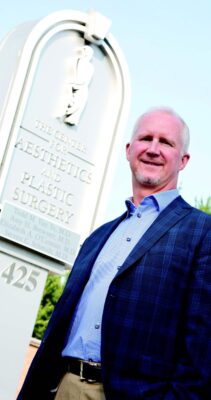Functionality often overlooked in the perception of plastic surgery
One of Dr. Todd Van Ye’s most powerful testimonials highlighting the health aspects of plastic surgery didn’t even require him to don a surgical gown.
In fact, he never even entered the operating room.
 “I remember I was on the physician panel for a NOVO Health conference and was speaking about the importance of taking care of your skin,” Van Ye said. “A while later I received a note that said ‘Don’t ever think plastic surgeons don’t save lives. Because of your talk I had something on my leg looked at and it turned out to be melanoma. I had it removed and, fortunately, I am cured now.’”
“I remember I was on the physician panel for a NOVO Health conference and was speaking about the importance of taking care of your skin,” Van Ye said. “A while later I received a note that said ‘Don’t ever think plastic surgeons don’t save lives. Because of your talk I had something on my leg looked at and it turned out to be melanoma. I had it removed and, fortunately, I am cured now.’”
In an era when the practice is defined in the public arena by the size and shape of certain body parts, the functionality of helping patients recover and keep their health is easy to overlook. Yet, it is one of the primary functions of plastic surgery, a function of which Van Ye is a passionate advocate.
“We don’t just make Barbie dolls”
Dr. todd M. van ye
It’s a constant battle to overcome the Hollywood perceptions and myths challenging the work Van Ye and his colleagues perform on a daily basis.
“What we do is focus on the form AND the function,” Van Ye said. “That includes much of the reconstructive work we do, which could be cancer to breast reconstruction to wound care. What we do is work with the soft tissues to restore the function and then the form.”
While popular perceptions might link the emergence of plastic surgery to the recent era, it is actually quite an old practice in medicine, with roots tracing back to India and a physician known as Sushruta who documented his procedures for using skin grafts to repair wounds and for a very early version of a nose reconstruction.
Plastic surgery truly established itself in the early part of the 20th century in repairing the horrific damage done to human bodies on the battlefields of World War I. Practitioners had to restore both the function and the form of the human body following the clash of 19th century military tactics and 20th century, industrialized weapons.
So what does Van Ye mean by functional?
Certainly, he starts by mentioning wound care, but other procedures he regularly performs that are focused on function and better health more than aesthetics include:
- Breast reduction. Many women suffer years of pain, discomfort, medication and work attendance issues before they seek the procedure to reduce the size of breasts that are too big for their body type.
- Septoplasty rhinoplasty. Restoring normal and unobstructed breathing is the primary function of this procedure. Yes, it can also address the appearance of the nose, but making it easy to breath should never take a back seat.
- Eye lid surgery. Not always covered by insurance, but a critical procedure for many who find their vision obstructed by heavy and oversized eyelids. “Not bumping your head while on the job or being able to drive and see things before turning are pretty functional improvements,” Van Ye said.
Correcting birth defects or genetic anomalies. While it definitely creates a cosmetic improvement, it corrects a functional problem and truly improves lives.
“Breast reductions have a huge functional component and are probably the number one procedure I perform in terms of 100 percent patient satisfaction,” Van Ye said. “It really changes their quality of life.”
As recently as 2018, there were nearly 6 million plastic surgery procedures performed in the United States where the primary objective was to improve function and the quality of life, according to the American Society of Plastic Surgeons (ASPS).
“Plastic surgery is more than just cosmetic procedures. (More than) 80 percent of ASPS member surgeons perform reconstructive plastic surgery, including the treatment of abnormal structures of the body caused by trauma, infection, tumors, disease, congenital defects or developmental abnormalities,” according to ASPS documents. “These procedures are generally performed to improve function.”
Nationally, the top reconstructive procedures include tumor removal, laceration repair and maxillofacial surgery.
In comparison, plastic surgeons perform about 1.8 million cosmetic surgical procedures. Non-surgical procedures such as micro abrasion or laser hair removal dwarf both the surgical categories, with about 16 million performed in 2018, according to ASPS data.
Not that aesthetics should ever be discounted. Both ASPS and Van Ye note the importance of cosmetic procedures on the psyche of patients, an important aspect of overall mental and physical health.
But just as important is overcoming the perception that plastic surgery is all about looks, not treating disease and improving patients’ lives.
“So the function has been missed in recent years,” Van Ye said. “There is often a blending — perhaps one of the end results is your stomach looks better in a swimsuit, but I got there because I was reconstructing something and correcting a problem.”
Todd M. Van Ye, MD is founder and medical director of The Center for Aesthetics and Plastic Surgery. He is a board-certified plastic surgeon, fully trained in general surgery, and has been practicing since 1997. The Center is part of the NOVO provider panel and offers bundled procedures including upper eyelid surgery, breast cancer reconstruction and breast reduction.

